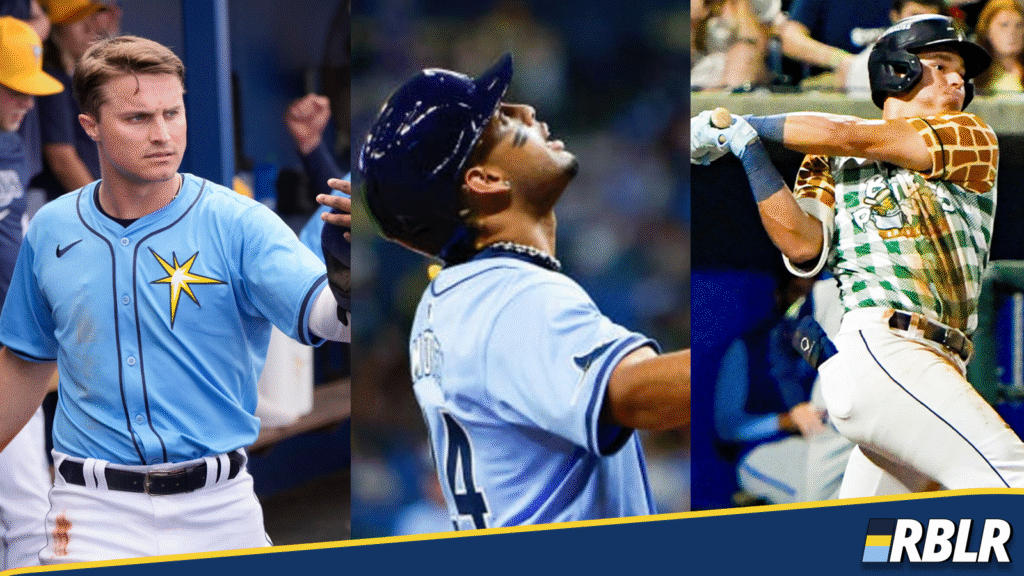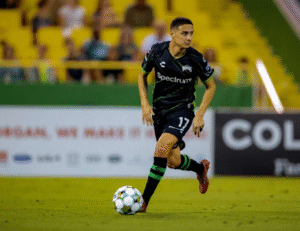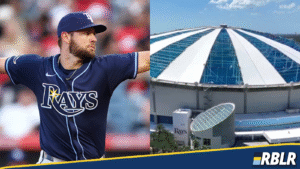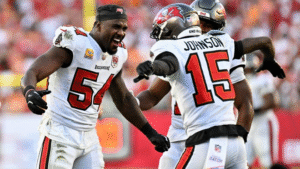RBLR Roundtable #33 – End of Year Musings

This week, our writers closed the book on 2025 and began asking the questions that the Rays will need to answer in 2026 and beyond: who can the major league club count on next year, and which prospects could be counted on to contribute in the future?
Jacob Macauley (@raysfarmreport) : Outfield questions
It’s pretty shocking to see a team finish: 3rd in K-BB%, 16th in wRC+, 6th in DRS, and 2nd in BsR not find results. As you could imagine, that team is the 2025 Tampa Bay Rays, a group that is going to either finish 6 or 8 games under .500, barring the conclusion of the final matchup in Toronto. How could a team be so productive yet yield negative results?
The Injuries In The Outfield
The Rays outfield this season, from injuries to lack of productivity from their players, it was just a flat-out bad year for this group. The Rays opened up the first month of the season with three of their opening day outfielders landing on the IL for an extended period of time (Palacios, JLowe, and DeLuca). Each of them came back at some point, but for DeLuca and Palacios, they’ve each logged fewer than 60 plate appearances this season, and as for Josh Lowe, it was a challenging year for him, logging exactly 0.0 fWAR in 431 plate appearances.
Over-Exposed Depth
If you had asked President of Baseball Operations Erik Neander how he envisioned the outfield playing time distribution being handled, I find it doubtful he would have wanted rookies Jake Mangum and Chandler Simpson to each log over 400 plate appearances, but after the injuries to Palacios and DeLuca, each were called upon to absorb expanded roles. Each of Simpson and Mangum were honorable in their efforts to hang as every day major leaguers. Both of them were above 90 wRC+, and they were both plus base runners.
Can you rely upon Jake Mangum 2026?
It’s unlikely that the Rays roll into 2026 with both of these guys penciled into everyday major league roles. Mangum ran hot on BABIP this season (~95th percentile BABIP), and his minor league track record (career 110 wRC+), lowly projections, and poor batted ball data suggest he will more than likely not perform to a 97 wRC+ again. Does that suggest he has no value? Of course not. Mangum profiles very well as a 5th outfielder with his 6 OAA (91st percentile), 75th percentile base running, and fairly neutral platoon splits still make a valuable depth piece with minor league options.
Can you rely upon Chandler Simpson for 2026?
Old School fans marvel at his high batting average and high stolen base total, while others remark about his low slug and OAA, but in reality, he probably just lands in between what both sides think. With the uncertainty about DeLuca at the major league level, Simpson will more than likely have a fair shot out of spring if he’s able to improve his 11th percentile effort defensively. The offensive skillset is still too unique and valuable to not find a spot for Simpson; he landed in the 95th percentile in zone-contact%, and also landed in the 90th percentile in BsR. The final hurdle for Simpson to reach his full potential as a major league hitter is just swing decisions. Simpson had a 31.4% Z-O-swing%, landing him near the bottom in MLB. So to answer the question, can he be relied upon? I would say yes, but making him your everyday leadoff hitter for another season isn’t something the Rays should do.
Concluding Thoughts
There is certainly potential for a more productive group heading into 2026, with bounce-back candidate Christopher Morel running a 124 wRC+ in his last 24 games, a healthy DeLuca, and Palacios should help immensely, and getting top prospect Tre Morgan, who saw some time in left field in AAA. All of these factors and maybe some slight reshuffling, definitely provide optimism moving forward
Jake Shutters (@JakeShutters) : Moving on from Morel
Another player who had high expectations but faltered in 2025, leading to the OF group struggling as a whole, was Christopher Morel. Morel was below replacement level in 2025, running a 90 wRC+, 35% K%, .289 OBP, and –3 DRS heading into the final game of the season.
Morel dealt with inconsistent playing time all year and never really got a chance to fully get going, but he played poorly when he was given opportunities. For a Rays team that dealt with major issues in the outfield, especially when it came to depth and having a deeper lineup, Morel’s struggles created a huge problem for others on the roster; some had to step-up in roles they weren’t ready for. The Rays outfield group as a whole ranked 21st in OBP and 24th in SLG, contributing to a bottom-5 group in wRC+ and a bottom-10 group in fWAR.
So what’s next for Morel? It’s hard to imagine that he would return to Tampa Bay next year, as his Rays career has been brutally underwhelming thus far, given that he has been worth –0.9 fWAR in 153 games played as a Ray. He will also be entering arbitration next year. In an offseason where I believe key, tough decisions need to be made to ensure the Rays will not endure a third straight losing season, the decision to move on from Morel and flip over the outfield group, I believe, is one of the easier ones the front office will have to make this winter.
Dustin Teuton (u/FLBoy19) : Prospect evaluations
When evaluating prospects, I start with age to level, often the most important factor in MiLB production. A 24-year-old in Double-A typically faces pitchers of similar age, but a 20-year-old is competing against players often five years ahead in physical and mental development.
Some analysts generally credit each year younger than level average as worth 5–10 extra points of wRC+. I then try to examine production in a vacuum, beginning with BB/K ratio and isolated power (ISO) to gauge plate discipline and ability to impact the ball. A younger hitter shouldn’t look overmatched; they need to compete at the plate and if need be offset higher strikeouts with a healthy walk rate, all while punishing mistakes.
Next comes advanced metrics like wOBA and wRC+. Regardless of age to competition, a legitimate MLB-caliber bat shouldn’t sit below league-average wRC+, and their wOBA should be near the MLB baseline of .320 to project at least as a platoon contributor. I then consider BABIP and batted-ball data to parse baseball’s randomness. If a hitter carries a high BABIP, I check whether ISO and line-drive rate support it. Finally, I add in positional value and overall context of age to level. All together I then parse through stats to determine prospects who have the potential to be MLB players.
Theo Gillen stands out arguably the most under this framework. At 19 in a league where pitchers average 21 years old, Gillen posted a .119 ISO and a 0.85 BB/K ratio—proof he isn’t overpowered by older arms. His .414 wOBA and 149 wRC+ show he drives the ball for extra-base hits with discipline, and his 24.9% line-drive rate supports his .359 BABIP—production in line with expectations for a top Rays prospect.
Jadher Areinamo, is more under the radar, acquired via the Danny Jansen trade, the Rays placed him immediately in AA at 21, where pitchers average 24–25 years old. He logged a .142 ISO and 0.63 BB/K—competitive versus older arms—backed by a .337 wOBA and 111 wRC+, both above league average. Notably, he produced those metrics with just a .264 BABIP, a 24.8% line-drive rate, and a modest 34.7% fly-ball rate, hinting at some bad luck. Turning 22 next season, he’s a strong candidate for a 2026 breakout and could emerge as a possible answer Tampa Bay’s 2nd baseman of the future with Brandon Lowe set to be a free-agent after the 2026 season.
The RBLR Rays Roundtable is a weekly collection of analysis, insight, and perspectives from a cast of writers assembled because of their unique backgrounds and experience. Check this space weekly for new updates and features covering the Tampa Bay Rays, the Rays’ minor league prospects, and more!







